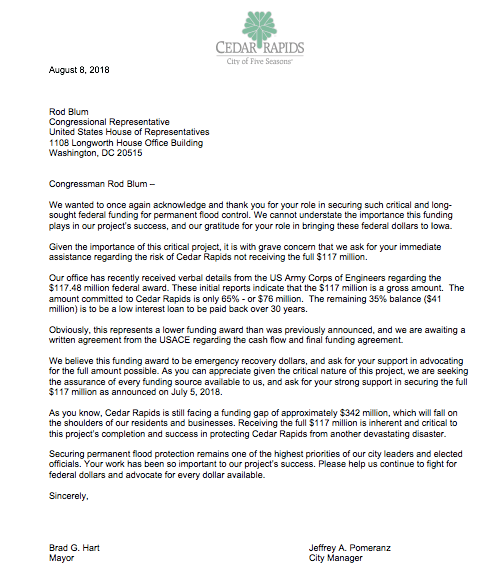
The $117 million in federal funding for the Cedar Rapids flood wall is not as was originally publicly promised, Starting Line has confirmed from multiple sources.
Last month, city leaders were informed by the U.S. Army Corps of Engineers that $41 million of the federal funding that was announced in July will instead be a low-interest loan that the city must repay over 30 years. That would present a significant increase in costs to the city to build the wall needed to prevent against future catastrophic floods.
Mayor Brad Hart and City Manager Jeff Pomeranz wrote to Congressman Rod Blum in early August about their “grave concern” that Cedar Rapids may not receive the full $117 million. Cedar Rapids already faces a $342 million gap in funds for the $750 million required to complete the project over 20 years, which could fall on local taxpayers’ shoulders to fund if they can’t find the money elsewhere.
The city leaders told Blum that getting the full $117 million as a grant is “inherent and critical to this project’s completion and success.”
Starting Line recently obtained the letter sent to Congressman Blum:

There was considerable fanfare from local and federal elected officials in Iowa after the announcement of the federal government’s funding pledge. Cedar Rapids has been working for ten years since the historic 2008 flood to obtain financial assistance to complete their new flood wall. Several prominent Republican officials, including Congressman Rod Blum and Senators Joni Ernst and Chuck Grassley took some victory laps over the $117 million.
.@RepRodBlum, @SenJoniErnst, and @ChuckGrassley didn’t rest until Cedar Rapids was given the funding it needs for a flood wall.
Sign the petition to thank our Republican leaders for putting Iowans first! https://t.co/OOw9tKxBhv #UnitedIowa #iapolitics pic.twitter.com/53dUef7dZG
— Iowa GOP (@IowaGOP) July 6, 2018
Vice President Mike Pence visited Cedar Rapids shortly after the July 5 announcement of funding, publicly thanking Blum for his leadership in the effort.

Cedar Rapids threw a “Flood Control Thank You Celebration” for Blum, Ernst and Grassley on August 8. City officials, however, learned of the $41 million loan change just before the event, sending the urgent letter to Blum’s office on the same day as the celebration.
Starting Line’s sources say that lobbying efforts continue behind the scenes to push the federal government to get the $117 million back to a full grant status. An initial story from the Gazette noted that Grassley’s office broke the funding down to $76 million in federal costs and $41 million in non-federal costs, but those involved in the discussions tell Starting Line that it was fully understood by the city at the time of the announcement that all the $117 million was to be provided to Cedar Rapids without some sort of loan agreement.
The timing on the new information may be important in Blum’s case, considering he sent out mailers from his congressional office, which some residents received on August 13 according to a Bleeding Heartland reader, touting his success in securing “$117 million from the federal government.”
The issue of flood protection is a pressing one once again for Cedar Rapids as the past week’s significant rainfall has prompted the city to erect some temporary flood barriers once again.
So far, the city has committed $110 million to the flood wall, $10 million of which has already been invested. $267 million has been provided by the state. $10 million in grants were already approved by the federal government. The county has yet to pitch in its own funding. If the $117 million comes in from federal sources in full, the city will still to need to to raise about $342 million.
Requests for comment from Cedar Rapids’ mayor, city manager, Congressman Blum and Senator Ernst’s offices were not responded to.
by Pat Rynard
Posted 9/5/18

2 Comments on "Federal Funding For Cedar Rapids Flood Wall Is Not As Advertised"
Those three are only concerned with the amount to self-congratulate about. They couldn’t care less if some of it (or even ALL of it!) comes in the form of loans.
All they care about is, “See? You’re getting your money!” Caring that the sources of the funds were misrepresented to Cedar Rapids? Meh. Not so much.
The writing is on the wall, so to speak. The feds are not going to be generously funding flood walls, levees, and other water-diversion structures from now on.
And even if they did, there will be a lot more official concern about exactly where diverted floodwaters go and what they do to the land and towns downstream. Not to mention their erosion and pollution impacts. And thanks to climate change, the heaviest rain events that surprise and horrify us now will become far more common.
So Iowa is going to have to finally get serious about protecting flood plains from development and holding more rain where it falls. Just restoring organic matter to our unhealthy farm soils would help a lot. So would more wetlands. Short version, we need to undo some of the destruction we’ve wrought upon Iowa’s landscape, soils, and hydrology since the 1840s.
Ironically, we are learning now that the original wetlands that we eliminated at such expense and with such enthusiasm functioned much better than our restored wetlands do. But restored wetlands can do a lot, and we can have better wetlands if we pay for them. Perhaps most of all, we need to stop letting Big Ag and rich developers decide what our water and flood policies will be. Enough is enough.